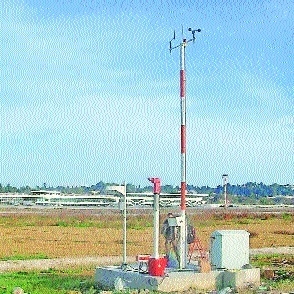Two RVR systems installed at city airport, to provide real-time visibility data to flights
| Date :16-Feb-2025 |

By Kaushik Bhattacharya :
With 99% accuracy, now ATC can relay accurate visibility status of runway to pilots n Process to install third RVR is underway
To enhance the flight safety at Dr Babasaheb Ambedkar International Airport, the Aerodrome Meteorological Offices (AMO), Nagpur has installed two advanced Runway Visual Range (RVR) systems, recently.
The RVRs were installed at Runway Nos 32 and 14. One more will be operational soon as its installation is underway, informed Dr Rizwan Ahmed, Director and Scientist-D, AMO Nagpur, to ‘The Hitavada’.
Dr Babasaheb Ambedkar International Airport Nagpur is the primary aviation hub of Central India and to increase the visibility of daily visiting flights in city this system was required.
AMO Nagpur, the nodal airport responsible for the technical guidance and supervision of
all airports in Madhya Pradesh, Chhattisgarh, and Vidarbha, spearheaded this upgrade to enhance aviation safety and operational efficiency across
the region.
“These state-of-the-art sensors provide real-time visibility data, ensuring safer landings and take-offs, particularly during low-visibility conditions such as fog, heavy rainfall, or haze,” said Dr Ahmed.
The RVR system continuously measures the visual range along the runway using sophisticated optical and atmospheric sensors, replacing the traditional polar diagram method for visibility measurement. The collected data is then transmitted to air traffic controllers and pilots, enabling precise decision-making and minimising flight disruptions, said the Director.
Air traffic controllers use RVR readings to establish airport operating categories and issue control instructions, while pilots use it to determine if they can proceed with a landing or takeoff.
The deployment of these advanced systems aligns Nagpur Airport with global safety standards while enhancing operational efficiency.
The RVR system plays a crucial role in helping pilots navigate during adverse weather conditions, ensuring uninterrupted airport operations.
“The process of implementing RVR system in any airport is a time consuming process as it require proper clearances from Directorate General of Civil Aviation (DGCA) and other government organisations.
For Nagpur airport, it took two years to implement the complete process. We succeeded in making two RVRs operational so far, and the third one is under installation process,” said the senior scientist.
“So far, the process was manual as our staff inform the
air traffic control by guessing
the distance of visibility and studying the polar diagram. Now, it is completely automated with 99 per cent accuracy,” said
Dr Ahmed.
AMO procured these equipment from ‘Vaisala Oyj’, a Finnish company that produces products and services for environmental and industrial measurement. With this upgrade, Nagpur Airport further strengthens its position as a key aviation
hub, delivering seamless and secure flight operations. The successful commissioning of the mid-runway RVR system will further optimise visibility assessments, reinforcing safety protocols for both domestic and international flights.
